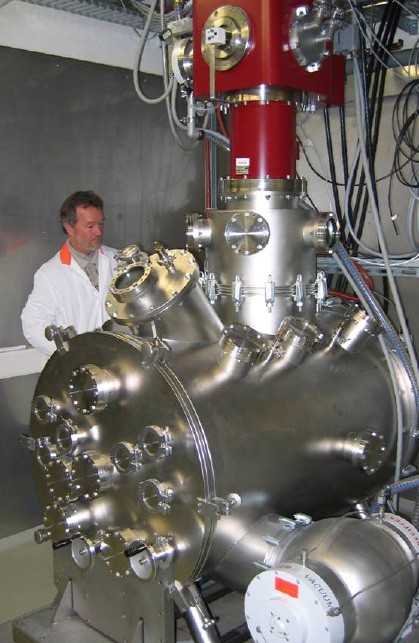ITER NEWSLINE
44
Progress in materials research
Dr. Jochen Linke, Forschungszentrum Julich
Progress in materials research

High heat flux test facility JUDITH 2 installed in the Hot Materials Laboratory at Forschungszentrum Julich
Materials research at FZJ is based on two powerful and extremely flexible electron beam test facilities which are capable of simulating all the thermal loads that are expected to occur in ITER or other future magnetic confinement experiments. This unique test equipment is installed in a hot cell laboratory which allows complex high heat flux tests with irradiated or toxic materials. Detailed analyses have been performed to determine the thermal fatigue life time of actively cooled high heat flux components under cyclic quasi-stationary thermal loads up to 20 MW/m2. Transient thermal loads with extreme power densities in the GW/m2 range and pulse durations of a few milliseconds or shorter are applied to simulate Edge Localized Modes (ELMs) or abnormal events such as plasma disruptions and vertical displacement events.
Substantial material degradation is expected to occur under neutron irradiation, although the integrated neutron fluence in ITER is still moderate if compared with future fusion reactors, i.e. in the order of ~1 dpa for the First Wall and a tenth of dpa for the divertor. To provide evidence that plasma facing components in ITER will not show any unacceptable neutron-induced degradation, systematic irradiation studies have been performed in material test reactors with ITER-relevant neutron induced damage level. Irradiated test specimens and small-scale modules have been analyzed in a comprehensive test campaign. From these tests it became evident that in particular carbon based materials are extremely sensitive and show a significant decrease in thermal conductivity even at rather moderate neutron doses. As a consequence, actively cooled high heat flux components with CFC-armour tend to overheat if neutron-irradiated and, therefore, can only operate up to the early stage of the tritium phase. This is in line with the present divertor armour strategy, which foresees a switch to a full-tungsten divertor before entering into the nuclear phase of ITER operation. On the other hand, tungsten armoured plasma facing components are affected only marginally in the so-called "monoblock" geometry. Today this design option represents the most robust design solution for high heat flux components which is good news for ITER, and, maybe, also for future fusion devices such as DEMO.
return to Newsline #44


